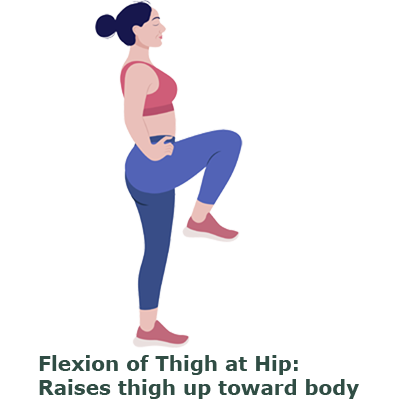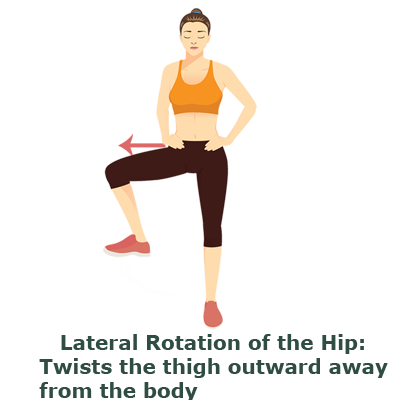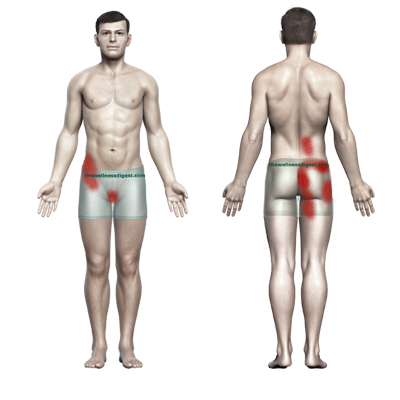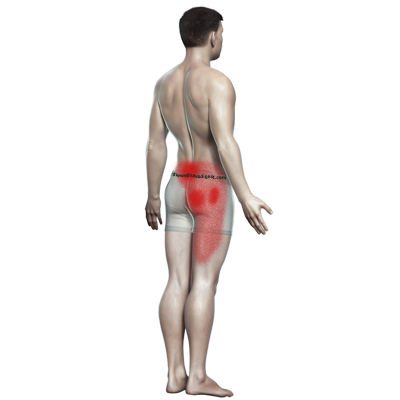
The iliopsoas unites three key muscles in your lower back, hip, and pelvis: the iliacus, psoas major, and psoas minor. The iliacus connects the hip bone to the upper leg, the psoas major joins the lumbar spine to the femur, and the psoas minor, when present, anchors the spine to the pelvis.
This muscle trio can trigger pain across the mid and lower back, hips, and buttocks, while also referring it to the lower abdomen, pelvis, and groin. Tightness or strain in this area is often the reason behind mysterious abdominal and backaches.
Do you feel a glitch in your hip? Find out why the iliopsoas may be the culprit!
Table of Contents
Where Are The Iliopsoas Muscles?

The iliacus muscle lines the inside of the hip bone (ilium) and connects to the top of the thigh bone (lesser trochanter of the femur).
The psoas major attaches to the lower back lumbar vertebrae (T12-L5) and descends with the iliacus to connect to the top of the thigh bone (lesser trochanter of the femur).
The psoas minor originates at the T12 and L1 vertebrae of the lower spine and travels down to connect to the pubis (pelvis bone).
Note: There are differing opinions concerning the psoas minor. Some do not include it as part of the iliopsoas muscle complex.
For detailed anatomy information: Iliopsoas Muscles Anatomy Page.
What Do The Iliopsoas Muscles Do?
The three muscles work together. providing power for these lower body movements.
- Picks up the thigh when you raise your thigh toward your stomach (flexion of the thigh at the hip)
- Twists the hip and leg outward (Rotation of the hip)
- Assists in bending (flexion) of the spine.




What Are The Iliopsoas Pain Symptoms?
The iliopsoas muscles can cause a wide range of symptoms, including low back pain, hip pain, groin pain, and pain in the lower abdomen. A tight psoas major muscle can mimic sciatica pain.
The pain is often a deep ache in the lower back, pelvis, and front of the hip that intensifies with prolonged periods of standing or sitting. This pain pattern is often mistaken for dysfunction in the hip or a hernia.
If abdominal and groin pain persist, please consult a physician to rule out any underlying medical conditions. Once medical conditions are ruled out, it is time to consider the iliopsoas muscle group.
The symptoms:
-
- Low back pain
- Hip pain and stiffness affecting your ability to straighten up at the hip
- Hip instability
- Groin pain
- Abdomen pain
- Thigh pain
- Difficulty standing from a sitting position
- Inability or severe pain when doing sit-ups or crunches
- A tendency to walk with one or both feet turned out
- Extreme dysfunction in the iliopsoas can cause pain under the shoulder blade extending down to the top of the hip.
Note: If the iliopsoas muscle is affected on one side, the pain travels vertically along the back, hip, and upper leg on the same side. If the iliopsoas muscles on both sides are affected, the pain spreads horizontally across the lower back, pelvis, and abdomen.
What Causes Iliopsoas Pain?
Sitting for long periods of time, especially with a slumping posture, keeps the iliopsoas muscles tight. This tension tugs on the spine and hip bones, causing pain and discomfort.
Overuse is another common culprit. Frequent climbing or running stairs, running, and abdominal exercises can fatigue the muscles, causing the development of trigger points. When muscle fatigue sets in, it is time to rest or stop.
Other causes:
-
- Weak abdominal muscles are responsible for much of the pain caused by the iliopsoas muscles.
- Sleeping on your side in the fetal position shortens the muscles.
- Shallow breathing or hyperventilating tightens the psoas major.
- Climbing stairs - the repetitive motion of bending at the hip to lift the leg can overwork the muscles.
- Wearing high heels affects the alignment of the pelvis, shortening the iliopsoas muscles over time.
- Carrying heavy bags or a child on one side creates muscle imbalance.
- Sleeping on a lumpy or soft mattress affects spinal alignment, straining the muscles.
- Abdominal surgical scars
Sports and activities that affect the iliopsoas:
-
- Running, power walking, and cycling - the repetitive up and down motion of the leg at the hip can lead to muscle soreness in the hips.
- Stair running overworks the muscle with each rapid lift of the leg.
- Soccer, football, basketball, and martial arts demand quick turns, kicks, and jumps that stress the iliopsoas.
- Gymnastics and dance push the muscles through extreme bending and extension of the hip and spinal vertebrae, sometimes going beyond the muscles limits.
How Do Trigger Points Affect The Iliopsoas Muscles?

Advertisement
How Can You Treat Iliopsoas Muscles Pain?
- Rest! Give the muscle time to recover. Avoid activities that flare up the pain, like running or stair climbing. Ditch the high heels. Once the ache settles, stretch the muscles. The lunge is gentle on the muscle and eases tightness. Step forward with the leg on the affected side, bend your knee, and push the hip forward. Hold for 20-30 seconds. Repeat on the other side.
- Heat can provide relief by relaxing the muscles. Apply for 15-20 minutes per hour.
- Strengthen to stabilize. Weak abdominal muscles are a primary cause of low back pain. Exercise like planks targets the abs and lower back, building strength. Start slow to avoid aggravating the muscles further.
- If you have abdominal scars from surgery, massage therapy can work wonders. The build-up of scar tissue affects the psoas muscle. Massage will reduce your pain and tightness while increasing your mobility.
How Can You Prevent Iliopsoas Pain?
-
- Bad posture plays a big role. Many of us slump when we sit, tightening the iliopsoas muscles. A lumbar support cushion will remind you to sit up straight, supporting your back, reducing the strain on the abdominal and lower back muscles. Alternate sitting and standing throughout the day. Take time to get up and walk around periodically.
- Strengthen to stabilize. Weak abdominal muscles are a primary cause of low back pain. Exercise like planks targets the abs and lower back, building strength. Start slow to avoid aggravating the muscles further.
- Sleeping on your side can throw your spine, hips, and legs out of alignment, putting stress not only on the iliacus and psoas muscles but also on the neck, back, and hip muscles. If it is the only position in which you sleep comfortably, a body pillow helps keep you in alignment, reducing daily pain and stiffness.
- Are you a shallow breather? Does your chest or abs expand to take in air when you inhale? It should be the abdominals. Practice inhaling deep into the stomach and exhaling slowly until deep breathing becomes a habit.
- If you have abdominal scars from surgery, massage is one of the best treatments to treat the restrictions in the scar area. The build-up of scar tissue affects the psoas muscle. Massage will reduce your pain and tightness and increase your mobility.
Interesting Facts About The Iliopsoas Muscles:
-
- They connect the upper body to the lower body and are important postural muscles. The muscles play a significant role in a human’s upright stature and ability to walk on two legs.
- The psoas major is the strongest hip flexor (lifts your leg up toward your stomach).
-
The iliopsoas is responsible for explosive movements, required in many sports
-
The muscles are important for maintaining balance and preventing falls in older adults.
- In approximately 50% of individuals, the psoas minor is absent
- Due to their deep location within the body, diagnosing issues with the iliopsoas muscles can be challenging. Healthcare professionals often use a combination of physical examination, imaging studies, and diagnostic injections to assess and treat iliopsoas-related pain and dysfunction.
- In ancient Greek mythology, the iliopsoas muscles or groin region were believed to be the seat of emotions and desires. This area was considered vulnerable in combat and was sometimes targeted by warriors.
It may not be only the iliopsoas muscles. Check other muscles that might contribute to these conditions:
ABDOMINAL PAIN | BUTTOCK PAIN | GROIN PAIN | HIP PAIN | LOW BACK PAIN | PELVIC PAIN | QUADRATUS LUMBORUM SYNDROME | SCIATICA | STENOSIS | TROCHANTERIC BURSITIS | UPPER LEG PAIN
Muscles With Similar Pain Patterns
Areas of Pain
Abdominal Pain | Ankle Pain | Arm (Low) Pain | Arm (Upper) Pain | Back (Low) Pain | Back (Upper) Pain | Chest Pain | Elbow Pain | Foot Pain | Groin Pain | Hand Pain | Head Pain | Hip Pain | Knee Pain | Leg (Low) Pain | Leg (Upper) Pain | Neck Pain | Pelvic Pain | Shoulder Pain | Wrist Pain
Muscle Groups
Abdominal, Low Back | Arm | Chest, Shoulder, Upper Back | Face, Head, Neck | Foot | Hand | Hip, Pelvis | Leg (Lower) | Leg (Upper) | Spine
If this information helped you, please share it so others can benefit.
References:
Clay, J. H., Allen, L., Pounds, D. (2015). Clay & Pounds' Basic Clinical Massage Therapy: Integrating Anatomy and Treatment (3rd ed.). Philadelphia, PA: Lippincott Williams & Wilkins
Davies, C,. Davies, A., (2013). The Trigger Point Therapy Workbook: Your Self-Treatmend Guide For Pain Relief (3rd ed.). Oakland, CA: New Harbinger Publications
Finando, D., Finando, S. , (2005). Trigger Point Therapy for Myofascial Pain: The Practice of Informed Touch (1st ed.) Rochester, VT: Healing Arts Press.
Muscolino, J., (2016) Kinesiology: The Skeletal System and Muscle Function (3rd ed.). Maryland Heights, Missouri: Mosby.


